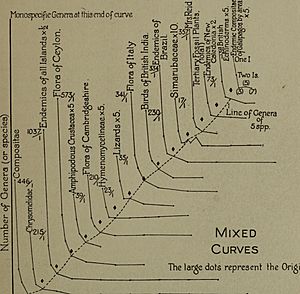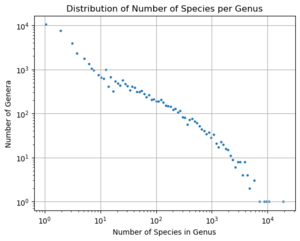Udny Yule facts for kids
Quick facts for kids
George Udny Yule
|
|
|---|---|
 |
|
| Born | 18 February 1871 Morham, Scotland
|
| Died | 26 June 1951 (aged 80) Cambridge, England
|
| Nationality | British |
| Alma mater | University College London |
| Known for | Yule distribution Yule's Y Yule's coefficient Yule–Simpson effect Yule–Walker equations Preferential attachment Simple birth process |
| Awards | Guy Medal (Gold, 1911) |
| Scientific career | |
| Fields | Statistics, Genetics |
| Institutions | University College London, University of Cambridge |
George Udny Yule (born February 18, 1871 – died June 26, 1951) was an important British statistician. He is well-known for the Yule distribution and for suggesting the idea of preferential attachment for how things connect in random networks.
Contents
Early Life and Family
George Udny Yule was born in a house called Beech Hill in Morham, Scotland. He passed away in Cambridge, England. His family was Scottish and included many army officers, government workers, and scholars.
His father, Sir George Udny Yule, was the brother of Sir Henry Yule, who was famous for studying Eastern cultures. George Udny Yule's great uncle, John Yule, was a botanist who studied plants.
Education and Career Journey
Udny Yule went to school at Winchester College. When he was 16, he started studying engineering at University College London.
From Physics to Statistics
After a year of doing physics research in Germany, Yule returned to University College in 1893. He became an assistant to Karl Pearson, who had been one of his teachers. Pearson was just starting to work in a new field called statistics. Yule decided to follow him into this exciting area.
Yule became an assistant professor, but in 1899, he took a better-paying job. He became a secretary for an examination board at the City and Guilds of London Institute.
Teaching and Writing
In 1902, Yule also became a lecturer in statistics at University College. He kept both jobs. During this time, he wrote many articles and a very important textbook. It was called Introduction to the Theory of Statistics (1911) and was based on his lectures.
In 1912, Yule moved to Cambridge University. He took on a new role as a lecturer in statistics. He stayed in Cambridge for the rest of his life.
Work During Wartime
During the First World War, Yule worked for the army. Later, he worked for the Ministry of Food. In 1931, he had a heart attack, which made him less able to work. This led to his early retirement. He published fewer papers after that. However, in the 1940s, he found new interests. One of these led to a book about studying words in literature using statistics.
Important Contributions to Statistics
Yule wrote a lot of important papers and books. His most famous book was Introduction to the Theory of Statistics. It was printed 14 times and translated into many languages.
He was very active in the Royal Statistical Society. He won their highest award, the Guy Medal in Gold, in 1911. He was also the society's president from 1924 to 1926.
Early Statistical Work
Yule's first paper on statistics came out in 1895. It looked at how poverty related to different types of aid. Yule was keen to use statistics to help solve social problems. He quickly joined the Royal Statistical Society.
For many years, only a few members were interested in mathematical statistics, including Yule. From 1897 to 1899, Yule wrote important papers about correlation and regression. These are ways to find relationships between different sets of data. After 1900, he worked on a similar idea called "association."
Yule had many different interests. He worked with experts in farming, weather, and medicine. He was also interested in Mendelian genetics, which led to several papers on the topic.
Studying Patterns Over Time
In the 1920s, Yule wrote three important papers about time series analysis. This is a way to study data that changes over time. For example, in 1927, he used a special model to study sunspot numbers. This helped understand patterns in how many sunspots appear over the years.
The Yule Distribution
In 1922, a scientist named John Christopher Willis published a book called Age and Area. It was based on his studies of plants in Sri Lanka. He looked at how many different species were in each group (genus) of plants.
Understanding Power Laws
Willis found that if you plotted his data on a special graph, it made a straight line. This showed that the number of groups with a certain number of species followed a "power-law" pattern. This means a few groups have many species, while many groups have only a few.
In 1925, Yule wrote a paper explaining this pattern. He suggested a process that could create this power-law distribution. This process was later called the Yule process. Today, it is better known as preferential attachment. This idea explains why some things, like websites or cities, grow very large while others stay small.
Another scientist, Herbert A. Simon, later named the resulting pattern the Yule distribution in Yule's honor.
Legacy and Impact
Frank Yates, a statistician, wrote about Yule after he passed away. Yates said that Yule might not have created completely new areas of statistics. However, he took the first steps in many directions that later became very important. Yates believed Yule was truly one of the first people to help create modern statistics.
Yule made big contributions to understanding correlation (how things relate), regression (predicting one thing from another), and how to study patterns over time. He was also a pioneer in using preferential attachment to explain power-law distributions. The Yule distribution, a type of power law, is named after him.
Even though Yule taught at Cambridge for 20 years, he did not have a huge impact on how statistics developed there. However, he did mentor some students, and his famous book was later updated by Maurice Kendall.
Selected Works
- Yule, G. Udny. Introduction to the Theory of Statistics London Griffin 1911.



